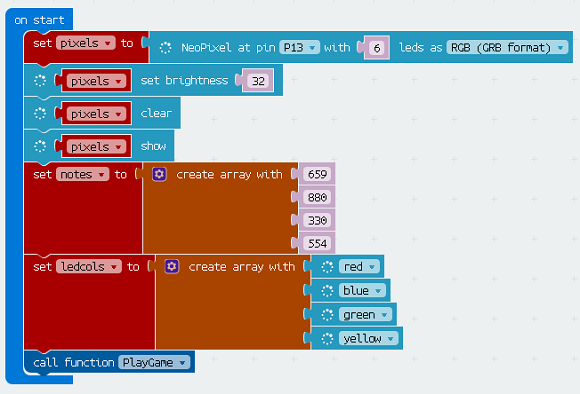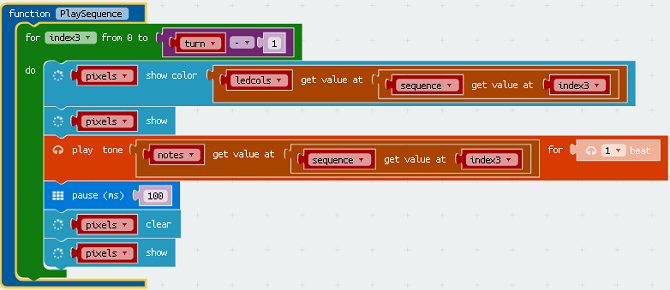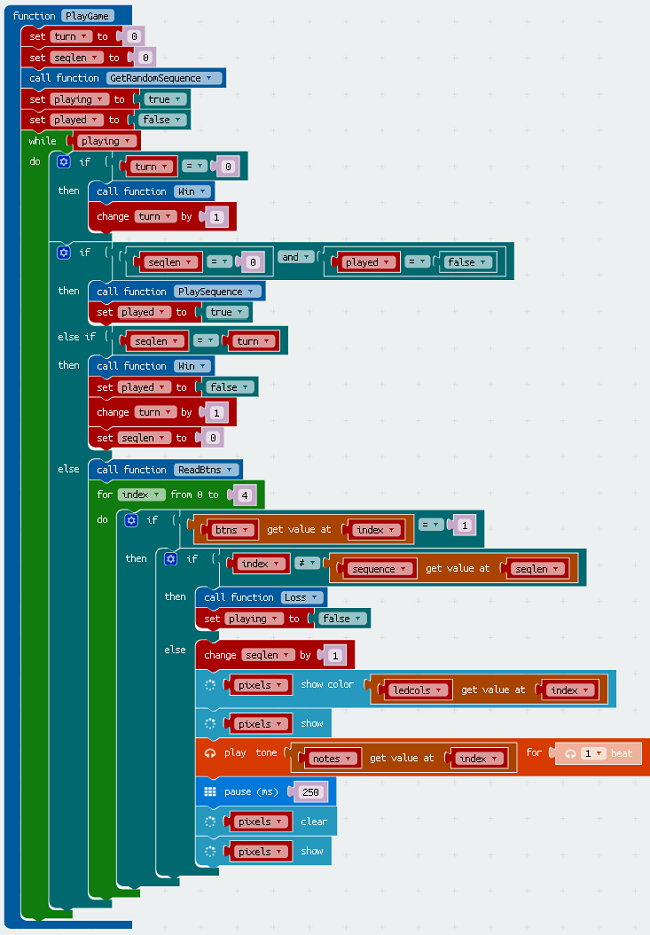BBC micro:bit
Bit:Commander - Simon Game
Introduction
I wanted to try to write a Blocks version of the Simon game that I had previously written in MicroPython. I don't really enjoy programming with blocks very much but thought the challenge worthwhile.
I was keen to make sure that I didn't use any JavaScript that could not be represented as blocks.

Programming
The Neopixel library is needed for this program.
I wrote this as a series of functions. Things can get out of hand very quickly with blocks.
Starting
When the micro:bit first starts, we set up the Neopixels and make sure that they are switched off. We make two arrays, one to store the frequencies of the notes that we want to play, another to store the colours of the buttons. The PlayGame function is called here. In a more polished version of the game, this would be triggered by some user interaction.

Generate A Random Sequence
This function makes an array of random integers from 0 to 3. The sequence length is fixed at 100 items. The game will crash if that limit is reached. Code could be added to detect this situation and call it a win of some sort. People usually drop out somewhere before 20.

Reading The Buttons
This function creates an array of the button states. This is a convenient way to read them all in one go.

Win Sound Effect
This is a little lazy. It plays the notes very quickly, one after the other, doing this 4 times. This could be improved.

Loss Sound Effect
This is just a low note, played for a while.

Playing A Part Of The Sequence
To make the game work, we need a way of playing the sequence for the player. This function does that. It depends on a varaiable called turn. That variable is set and changed in the PlayGame function.
A loop is used to play the sequence as far as we need to. The LED colours and notes are worked out using the arrays we set up earlier.

Playing The Game
This function took a few more blocks. The main playing loop checks for one of 4 conditions. The first situation is the start of the game. A win effect is played. The next condtion is that the user has not yet heard the sequence that they need to enter. The sequence is played. Then a check is made to see if the player has correctly entered the sequence. A win effect is played and the turn advanced by 1. In the last clause, the buttons are read. If a button is being held down, it is checked against the sequence. If it is incorrect, a loss effect is played and the game is done. If it is correct, a record of how far the player is into the sequence is kept and the game continues.

JavaScript
If you add the Neopixel library, you can copy and paste the JavaScript (listing at end of page) into the JavaScript window and then click to see the blocks.
let played = false
let notes: number[] = []
let ledcols: number[] = []
let playing = false
let seqlen = 0
let turn = 0
let sequence: number[] = []
let btns: number[] = []
let pixels: neopixel.Strip = null
function GetRandomSequence() {
sequence = [Math.random(4)]
for (let i = 0; i < 99; i++) {
sequence.push(Math.random(4))
}
}
function Loss() {
music.playTone(131, music.beat(BeatFraction.Double))
basic.pause(1000)
}
function Win() {
for (let i = 0; i < 4; i++) {
for (let index2 = 0; index2 <= 3; index2++) {
music.playTone(notes[index2], music.beat(BeatFraction.Eighth))
}
}
}
function PlaySequence() {
for (let index3 = 0; index3 <= turn - 1; index3++) {
pixels.showColor(ledcols[sequence[index3]])
pixels.show()
music.playTone(notes[sequence[index3]], music.beat(BeatFraction.Whole))
basic.pause(100)
pixels.clear()
pixels.show()
}
}
function ReadBtns() {
btns = [pins.digitalReadPin(DigitalPin.P12), pins.digitalReadPin(DigitalPin.P15),
pins.digitalReadPin(DigitalPin.P14), pins.digitalReadPin(DigitalPin.P16)]
}
function PlayGame() {
turn = 0
seqlen = 0
GetRandomSequence()
playing = true
played = false
while (playing) {
if (turn == 0) {
Win()
turn += 1
}
if (seqlen == 0 && played == false) {
PlaySequence()
played = true
} else if (seqlen == turn) {
Win()
played = false
turn += 1
seqlen = 0
} else {
ReadBtns()
for (let index = 0; index <= 4; index++) {
if (btns[index] == 1) {
if (index != sequence[seqlen]) {
Loss()
playing = false
} else {
seqlen += 1
pixels.showColor(ledcols[index])
pixels.show()
music.playTone(notes[index], music.beat(BeatFraction.Whole))
basic.pause(250)
pixels.clear()
pixels.show()
}
}
}
}
}
}
pixels = neopixel.create(DigitalPin.P13, 6, NeoPixelMode.RGB)
pixels.setBrightness(32)
pixels.clear()
pixels.show()
notes = [659, 880, 330, 554]
ledcols = [neopixel.colors(NeoPixelColors.Red), neopixel.colors(NeoPixelColors.Blue),
neopixel.colors(NeoPixelColors.Green), neopixel.colors(NeoPixelColors.Yellow)]
PlayGame()
This needs some improvement, but there is enough for a start.

